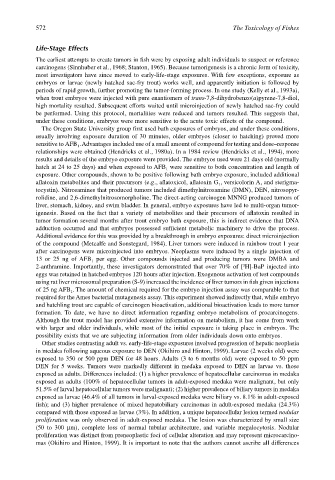Page 592 - The Toxicology of Fishes
P. 592
572 The Toxicology of Fishes
Life-Stage Effects
The earliest attempts to create tumors in fish were by exposing adult individuals to suspect or reference
carcinogens (Sinnhuber et al., 1968; Stanton, 1965). Because tumorigenesis is a chronic form of toxicity,
most investigators have since moved to early-life-stage exposures. With few exceptions, exposure as
embryos or larvae (newly hatched sac-fry trout) works well, and apparently initiation is followed by
periods of rapid growth, further promoting the tumor-forming process. In one study (Kelly et al., 1993a),
when trout embryos were injected with pure enantiomers of trans-7,8-dihydrobenzo(a)pyrene-7,8-diol,
high mortality resulted. Subsequent efforts waited until microinjection of newly hatched sac-fry could
be performed. Using this protocol, mortalities were reduced and tumors resulted. This suggests that,
under these conditions, embryos were more sensitive to the acute toxic effects of the compound.
The Oregon State University group first used bath exposures of embryos, and under these conditions,
usually involving exposure duration of 30 minutes, older embryos (closer to hatching) proved more
sensitive to AFB . Advantages included use of a small amount of compound for testing and dose–response
1
relationships were obtained (Hendricks et al., 1980a). In a 1984 review (Hendricks et al., 1994), more
results and details of the embryo exposure were provided. The embryos used were 21 days old (normally
hatch at 24 to 25 days) and when exposed to AFB were sensitive to both concentration and length of
1
exposure. Other compounds, shown to be positive following bath embryo exposure, included additional
aflatoxin metabolites and their precursors (e.g., aflatoxicol, aflatoxin G , versicolorin A, and sterigma-
1
tocystin). Nitrosamines that produced tumors included dimethylnitrosamine (DMN), DEN, nitrosopyr-
rolidine, and 2,6-dimethylnitrosomorpholine. The direct-acting carcinogen MNNG produced tumors of
liver, stomach, kidney, and swim bladder. In general, embryo exposures have led to multi-organ tumor-
igenesis. Based on the fact that a variety of metabolites and their precursors of aflatoxin resulted in
tumor formation several months after trout embryo bath exposure, this is indirect evidence that DNA
adduction occurred and that embryos possessed sufficient metabolic machinery to drive the process.
Additional evidence for this was provided by a breakthrough in embryo exposures: direct microinjection
of the compound (Metcalfe and Sonstegard, 1984). Liver tumors were induced in rainbow trout 1 year
after carcinogens were microinjected into embryos. Neoplasms were induced by a single injection of
13 or 25 ng of AFB per egg. Other compounds injected and producing tumors were DMBA and
1
3
2-anthramine. Importantly, these investigators demonstrated that over 70% of [ H]-BaP injected into
eggs was retained in hatched embryos 120 hours after injection. Exogenous activation of test compounds
using rat liver microsomal preparation (S-9) increased the incidence of liver tumors in fish given injections
of 25 ng AFB . The amount of chemical required for the embryo injection assay was comparable to that
1
required for the Ames bacterial mutagenesis assay. This experiment showed indirectly that, while embryo
and hatchling trout are capable of carcinogen bioactivation, additional bioactivation leads to more tumor
formation. To date, we have no direct information regarding embryo metabolism of procarcinogens.
Although the trout model has provided extensive information on metabolism, it has come from work
with larger and older individuals, while most of the initial exposure is taking place in embryos. The
possibility exists that we are subjecting information from older individuals down onto embryos.
Other studies contrasting adult vs. early-life-stage exposures involved progression of hepatic neoplasia
in medaka following aqueous exposure to DEN (Okihiro and Hinton, 1999). Larvae (2 weeks old) were
exposed to 350 or 500 ppm DEN for 48 hours. Adults (3 to 6 months old) were exposed to 50 ppm
DEN for 5 weeks. Tumors were markedly different in medaka exposed to DEN as larvae vs. those
exposed as adults. Differences included: (1) a higher prevalence of hepatocellular carcinomas in medaka
exposed as adults (100% of hepatocellular tumors in adult-exposed medaka were malignant, but only
51.5% of larval hepatocellular tumors were malignant); (2) higher prevalence of biliary tumors in medaka
exposed as larvae (46.4% of all tumors in larval-exposed medaka were biliary vs. 8.1% in adult-exposed
fish); and (3) higher prevalence of mixed hepatobiliary carcinomas in adult-exposed medaka (24.3%)
compared with those exposed as larvae (3%). In addition, a unique hepatocellular lesion termed nodular
proliferation was only observed in adult-exposed medaka. The lesion was characterized by small size
(50 to 300 µm), complete loss of normal tubular architecture, and variable megalocytosis. Nodular
proliferation was distinct from preneoplastic foci of cellular alteration and may represent microcarcino-
mas (Okihiro and Hinton, 1999). It is important to note that the authors cannot ascribe all differences

